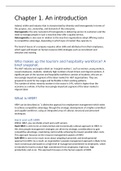Exam (elaborations)
EED2601 Assignment 4 2024 | Due 29 August 2024
- Institution
- University Of South Africa (Unisa)
EED2601 Assignment 4 2024 | Due 29 August 2024. Questions answered with references. Learners may prefer one or more of several learning styles, and on this basis, we place them in the following categories: auditory learners, visual learners and tactile learners. 1.1 Explain the following learni...
[Show more]













